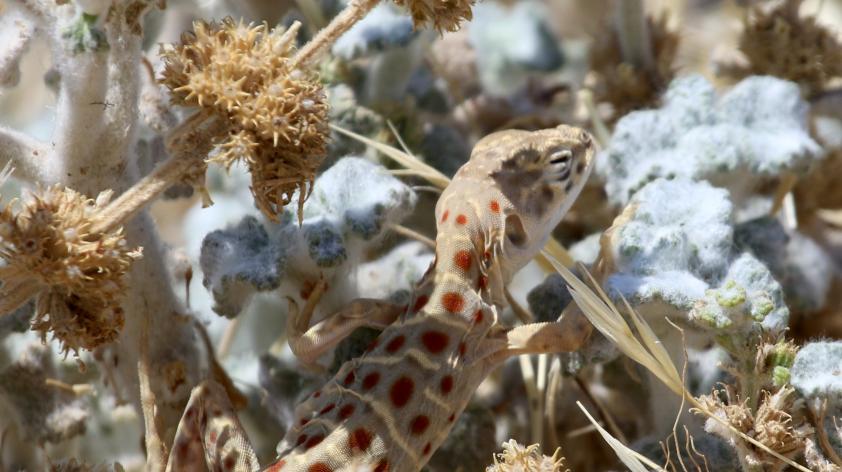
The Persistent “Blip” of the Blunt-nosed Leopard Lizard
Blip, blip. I turn the antenna left and the steady “blip” weakens… colder. I turn the antenna right and the “blip” is louder. Warmer, so I step towards it. If you just follow the “blip”, it will eventually lead you to the radio collar around the neck of a blunt-nosed leopard lizard.
The blunt-nosed leopard lizard (BNLL) is California’s most imperiled lizard species, though it certainly does not know that. Whereas most lizards will shy away into the nearest crevice when approached, BNLL will often run towards you. We’ve found them pouncing on grasshoppers, eating other lizards, and even snoozing in shrub branches.
This boldness has done little, though, to fend off the agricultural and urban development which has taken over 85% of their natural range. Habitat loss has been a big contributor to the BNLL’s classification as California’s only federally endangered lizard species. It also means we must manage the land that remains in a way that optimizes habitat quality for BNLL.
To do so, we must pinpoint exactly what features (ex: shrubs, burrows, etc.) of their environment are necessary for their success and better understand how those features may be affected by factors such as drought or invasive grasses. This year we wanted to know how they were using Ephedra californica, the primary shrub at our Carrizo Plain field site. Ephedraare a known foundation species within the San Joaquin desert ecosystem which may provide benefits to BNLL, such as shading them from predators or the scorching sun.
In May, researchers from BLM, Cal Poly, and York University worked together to catch and radio collar 30 lizards. From then on, we all traded off as the acting telemetry tech(s), tracking the lizards each day. When we found them, we simply took note of what they were doing (ex: hunting, mating, basking, resting) and where they were doing it (ex: in the open, under shrubs, in burrows).
By late July, most of them had abandoned the hunt for grasshoppers and taken shelter in burrows, where it was cooler. This marks the end of the telemetry season, but July was certainly not the end of the road. Once the lizards were gone, I did various follow-up shrub and burrow surveys as part of collaborative ecology studies between BLM and York University that are assessing how this year’s drought may have affected the growth of Ephedra.
Now, I am doing surveys for the BNLL’s bobble-headed offspring. Typically, when the adults go down, several newly hatched babies begin to pop up. However, this year I have seen only one juvenile at our northern site, a sign that their reproduction for this year may have been hindered by the drought.
Study by study, we’re gaining insight into the lifestyle and requirements of the blunt-nosed leopard lizard. BLM’s overall goal is to combine the knowledge gained from studies like this into a comprehensive management plan.
Perhaps it is the scaly exterior or the “cold-bloodedness” that makes reptiles especially hard for us to relate to, and therefore to care about.
However, these same features also make them especially vulnerable to climate change. And so I’ll leave you with my favorite quote; “In the end we will conserve only what we love; we will love only what we understand; and we will understand only what we are taught." (Baba Dioum, 1968.)
Thank you to Mike Westphal, wildlife biologist (and my BLM mentor) for BLM’s Central Coast field office. Also to Christopher Lortie, an ecologist and statistics wizard, and his lab from York University; as well as Emily Taylor’s vast PERL lab at Cal Poly, San Luis Obispo.













